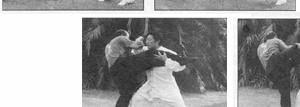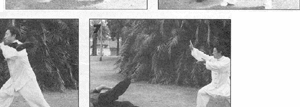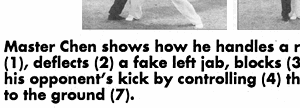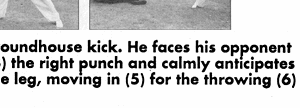Here's my attempt of doing a comprehensive translation the original Chinese article by Master Chen Xiaowang. Any feedback are greatly appreciated. - yz
The process of learning Tai-chi is no different from academic subjects; where a learner will slowly build up knowledge of these subjects from Primary/Junior level, to College and University level. A learner would not be able to comprehend what is taught at tertiary tertiary level without the fundamentals built during primary education, Similarly, the process of learning Tai-chi have to follow the same order, getting deeper in the subject progressively. To skip the steps and avoid the process of learning; liken a Primary school student attempting to study University subjects, would be greatly detrimental to learning and trapped in the dead-end of learning.
Several Chen Style Ta-chi's literature introduces a lot of high level application techniques which requires a high level of skills and competency to be accomplished. The content will require the reader to have a certain level of competency to comprehend and appreciate, and there's often not many content that will be suitable for beginner and intermediate learners. These content will often make the learners feel a great disparity between themselves and the arts, and could be very discouraging to them as well. A beginner who attempts to match the competency level of such content will be akin to a Primary school student trying to understand University's text whereby many confusion will arises and gives up easily.
To resolve this problem, I shall introduce the progressive stages of Tai-chi practice, from stage one to five, defining each stage's competency's performance and goal. The purpose is to allow all Tai-chi enthusiast to identify which stage of the training they are currently at based on their existing framework, what they should their training goal be at this stage, and the application practical for them at such stage. They will thus be able to progress towards mastery more systemically by having such a wholesome view and direction of their training.
First Stage of Training
The first stage of training begins the moment we start learning the first move in the first old form of Chen Style Tai-chi whereby moving forward, we will have to adhere to the direction, angle, position, kinesthetic coordination and other physical postures requirements when practising until we start to have a feel of "chi" within the body.
There are a set of principles a practitioners have to fulfill when practicing Tai-chi which are namely; "Keeping the body straight", "Keeping head upright, pushed up yet relax", "Relax the shoulder and drop the elbow", "Hollow the chest and collapse the waist", "Relax the hip and bend the knees"; to reach the level where the mental state is calm and the "chi" will then sink to the "dantian".
There is no way a beginner in Tai-chi would be able to fulfill all the requirements in training and thus, there will be no way they could comprehend the concept of sinking to the dantian.
The first stage of training have a more simplistic principles requirement towards the physical performance in practice. Example; "Keeping head upright, pushed up yet relax" just require learner to keep their head naturally upright. "Hollow the chest and collapse the waist" only require learner to keep the body upright and have a clear weight distribution between both legs. Learners would just have to follow the basic requirements of practicing even if they are unable to fulfill the requirements during initial attempts which is very common.
The principles for training do not need be adhere strictly, and over prescriptive of the requirements were only results in confusion and backlash. The practitioner will slowly fulfill all the necessary principles as he/she advances through the stages in training over time. Improvements in training happen layer by layer, with each layer getting better than another. A day of diligent effort, is a day of improvement. When we practise more, we will naturally get better over time.
With diligent practices and conscious awareness of the physical of the moves while start focus, a learner whom practice the form ten times a day would be able to "graduate" from stage one in six months time where he/she will become thoroughly familiar with the form. He/she could also increase the repetition of the form practice to suit his/her physical conditioning desire. The outcome of stage one training is where the learner start to feel the sensation of chi within his/her body where the physical movements direct the chi to motion, which is also the sign for the start of moving into training in stage two. We will be moving from familiarity to understanding of chi and jing starting from here.
There is no need for a learner at stage one to be overly concerned with the combat application and striking capability as the physical management of the body have yet to matured. The common mistakes learner make at this stage of combat are; inappropriate choice of actions, over emphasis of defense and not attack and vice-versus, not having a good overview of the situation. Over emphasizing of combat application at this level often lead to the body stiffing up and slowing down the development progress. It is highly advisable for learner to train more so as to let go of brute force in training gradually.
The performance of a practitioner at stage one will exhibit the following observations:
Motion will appear to be stiff with no mental intent, aggressive, over-exertion, sudden rise and drop, non-continuous and fluid movement, resistance in movements, non-circular and follow through movements.
The principles for a practitioner whom is practicing for health entirely will not need to follow the above requirements totally. He/She would just have to the body loose and relax, fluid and continuous.)
There are a set of principles a practitioners have to fulfill when practicing Tai-chi which are namely; "Keeping the body straight", "Keeping head upright, pushed up yet relax", "Relax the shoulder and drop the elbow", "Hollow the chest and collapse the waist", "Relax the hip and bend the knees"; to reach the level where the mental state is calm and the "chi" will then sink to the "dantian".
There is no way a beginner in Tai-chi would be able to fulfill all the requirements in training and thus, there will be no way they could comprehend the concept of sinking to the dantian.
The first stage of training have a more simplistic principles requirement towards the physical performance in practice. Example; "Keeping head upright, pushed up yet relax" just require learner to keep their head naturally upright. "Hollow the chest and collapse the waist" only require learner to keep the body upright and have a clear weight distribution between both legs. Learners would just have to follow the basic requirements of practicing even if they are unable to fulfill the requirements during initial attempts which is very common.
The principles for training do not need be adhere strictly, and over prescriptive of the requirements were only results in confusion and backlash. The practitioner will slowly fulfill all the necessary principles as he/she advances through the stages in training over time. Improvements in training happen layer by layer, with each layer getting better than another. A day of diligent effort, is a day of improvement. When we practise more, we will naturally get better over time.
With diligent practices and conscious awareness of the physical of the moves while start focus, a learner whom practice the form ten times a day would be able to "graduate" from stage one in six months time where he/she will become thoroughly familiar with the form. He/she could also increase the repetition of the form practice to suit his/her physical conditioning desire. The outcome of stage one training is where the learner start to feel the sensation of chi within his/her body where the physical movements direct the chi to motion, which is also the sign for the start of moving into training in stage two. We will be moving from familiarity to understanding of chi and jing starting from here.
There is no need for a learner at stage one to be overly concerned with the combat application and striking capability as the physical management of the body have yet to matured. The common mistakes learner make at this stage of combat are; inappropriate choice of actions, over emphasis of defense and not attack and vice-versus, not having a good overview of the situation. Over emphasizing of combat application at this level often lead to the body stiffing up and slowing down the development progress. It is highly advisable for learner to train more so as to let go of brute force in training gradually.
The performance of a practitioner at stage one will exhibit the following observations:
Motion will appear to be stiff with no mental intent, aggressive, over-exertion, sudden rise and drop, non-continuous and fluid movement, resistance in movements, non-circular and follow through movements.
The principles for a practitioner whom is practicing for health entirely will not need to follow the above requirements totally. He/She would just have to the body loose and relax, fluid and continuous.)
Presentation of Combat Techniques at Stage One
The practitioner at stage one training will have very limited capabilities in a combat situation as the kinesthetic coordination of the learner have yet to matured and thus will be overly stiff and defensive during combat. Practitioner will find him/herself abit uncomfortable or not "internally" coordinate during form practice and unable to exert force efficiently during exertion of power. Force will not be able to generated from ground up, and often exertion of force only results in "throwing" of the force.
There be no competent skills to divert any force or "dissolve" any efforts upon oneself, as practitioner is unable to secure his own "centre" and balance himself, making him very vulnerable to attacks.
The practitioner at stage one in summary is incapable to defend himself in fight, but could however still overcome others whom have never done any training, but with brute force and not with any skills or techniques that are associated with Tai-chi.
There be no competent skills to divert any force or "dissolve" any efforts upon oneself, as practitioner is unable to secure his own "centre" and balance himself, making him very vulnerable to attacks.
The practitioner at stage one in summary is incapable to defend himself in fight, but could however still overcome others whom have never done any training, but with brute force and not with any skills or techniques that are associated with Tai-chi.
第二层功夫的练习
第二层功夫的任务,是进一步去掉在练拳时,身手内外产生的僵劲和拙力,使身手内外协调一致,达到周身相随节节贯串,内气按拳架姿势的要求有规律地在体内里运行,达到一气贯通。
完成了第一层功夫,已经能够熟练地按逐势动作初步要求来练习,并且对内气活动已有明显的感觉,但是还不能进一步掌握住内气,这是因为在练拳过程中,身手内外不够协调,某一部位产生有矛盾,使内气不能贯通,意气不能合一,(何为矛盾?在练拳当中,肢体带有僵劲和用有拙力,使某一部位动作较快,过了,就会产生顶劲,某个部位动作较慢,不给,就会产生丢劲,凡是在运动过程中,动作不协调而产生偏倚,凹凸,缺陷之处,就是运动当中旌的矛盾),这些矛盾,只有进一步钻研,细心捉摸,才能逐步解决,身手内外不经过长时间的练习,虽然懂其要领,按其姿势练习,往往顾此失彼,正如写字,学会写再要求字的结构,这时,练拳者一定要注意,严格地掌握自己的身肢各部位,使之恰当,例如含胸塌腰,含胸过度则弯腰弓背,塌腰过度则挺胸扛肚,所以要把身肢各个部位的要求掌握适当,使矛盾对立统一起来,进一步结合和掌握放松的质量,使周身相合。周身相合分为内合和外合。外合,即手与足合,肘与膝合,肩与髋合,左手与右足合,左肘与右膝合,右边皆如此,手与身相合,头与手相合,身与步相合。内合,即筋与骨相合,气与力相合;心与意相合;肝与筋合;脾与肉合;肺与身,肾与骨合,心意合一,周身内外一齐合住,心意一开,内外俱开,同时开中寓合,合中寓开,一开连一合,开合递相承。
第二层功夫当中对身体各单位的要求比较严格,处处解决矛盾,力求内气贯通,有时某个部位稍微动一点,内气就马上顺下去,的确是差之毫厘,谬之千里。练拳者和身手内外,若有合不住的感觉,身体某个部位必然用了僵劲,产生了矛盾,将该部位调整恰当,气能顺,自然就会合住。
完成了第一层功夫,已经能够熟练地按逐势动作初步要求来练习,并且对内气活动已有明显的感觉,但是还不能进一步掌握住内气,这是因为在练拳过程中,身手内外不够协调,某一部位产生有矛盾,使内气不能贯通,意气不能合一,(何为矛盾?在练拳当中,肢体带有僵劲和用有拙力,使某一部位动作较快,过了,就会产生顶劲,某个部位动作较慢,不给,就会产生丢劲,凡是在运动过程中,动作不协调而产生偏倚,凹凸,缺陷之处,就是运动当中旌的矛盾),这些矛盾,只有进一步钻研,细心捉摸,才能逐步解决,身手内外不经过长时间的练习,虽然懂其要领,按其姿势练习,往往顾此失彼,正如写字,学会写再要求字的结构,这时,练拳者一定要注意,严格地掌握自己的身肢各部位,使之恰当,例如含胸塌腰,含胸过度则弯腰弓背,塌腰过度则挺胸扛肚,所以要把身肢各个部位的要求掌握适当,使矛盾对立统一起来,进一步结合和掌握放松的质量,使周身相合。周身相合分为内合和外合。外合,即手与足合,肘与膝合,肩与髋合,左手与右足合,左肘与右膝合,右边皆如此,手与身相合,头与手相合,身与步相合。内合,即筋与骨相合,气与力相合;心与意相合;肝与筋合;脾与肉合;肺与身,肾与骨合,心意合一,周身内外一齐合住,心意一开,内外俱开,同时开中寓合,合中寓开,一开连一合,开合递相承。
第二层功夫当中对身体各单位的要求比较严格,处处解决矛盾,力求内气贯通,有时某个部位稍微动一点,内气就马上顺下去,的确是差之毫厘,谬之千里。练拳者和身手内外,若有合不住的感觉,身体某个部位必然用了僵劲,产生了矛盾,将该部位调整恰当,气能顺,自然就会合住。
陈氏太极拳要求一举一动都不离缠丝劲,拳论中说:“缠丝劲发源于肾,处处皆有,无不然。”在运动中严格掌握缠丝法(即缠绕螺旋的运动方法),和缠丝劲(即用缠丝法练出来的劲),这是陈氏太极拳中的精华所在,缠丝法要求在松肩沉肘,含胸塌腰,开髋屈膝,以腰为轴一动全动,掌心内外翻转,手往里转,以手领肘,以肘领肩,以肩领腰(指的是该侧的腰,实质上还是以腰为轴)手往外转,以腰摧肩,以肩催肘,以肘催手。表现在上肢是旋腕转膀,表现在下肢是旋踝转腿,表现在身躯则是旋腰转背,三者结合起来,形成一条根在脚,主宰于腰而形于手指的空间旋转曲线。在练拳时,如果感到某一动作有不得势式不得劲处,就可以依据缠丝的顺遂处挪动一下腰腿,以求得顺遂,这样可使姿势得到纠正,所以在注意身肢各部位的要求,使周身相合的同时,掌握缠丝法的运动规律,是在第二层功夫练习当中解决矛盾的手段,和自我纠正的方法。如果有老师亲手捏架子,把身肢各个部位调整到位,使练拳者有一定的体会,思想上有一定的印象和认识,就比较容易掌握周身相结合和缠丝劲的方法。如果没有这样的条件,照书本自学,困难就大一些,应学习一些生理知识,特别是有关生理解剖和经络方面的知识,以利正确理解。
人体的内气,在经络中运行,好比灌溉田地,人身的经络,好象农田的沟渠,经络不闭则气通,沟渠不塞而水行。练拳时如果身肢产生了矛盾,内气就会受阻而中断,行不到梢节(两手、两足尖端),只有经过练习,使周身各部位符合拳架的要求,就能解决矛盾,达到节节贯串,恰如疏通了被堵塞的水渠,使内气畅通,发于丹田,达到梢节,因此,练拳时要力求顺便,动作协调。
在第一层功夫期间,练拳者开始学拳架,架子练熟就感觉到内气在身肢内活动,于是很感举,对练拳不会有厌倦之感。进入第二层功夫,却感觉不到什么新鲜之处,在这一段时期中,会出现许多走弯路和反复现象。所谓走弯路,就是练拳者对太极拳的要领产生误解,或是掌握不准确,产生片面的认识,因而在练拳中出现了错误,练一段时间自己就会感到别扭,不得劲,或者老师会指出其错误;所谓反复,就是有时练的非常顺遂,好象有很大进步,但又练一段时间,不仅感觉不能什么进步,反而浑身别扭,怎么练都不得劲,还有时候练的非常顺遂,发劲也是呼呼带风,推手时却用不上。所以在第二层功夫当中,练拳往往会产生烦闷情绪;或者怀疑老师保守,不传诀窍;或者是因为自己身体素质差,耐力不够。虽然对内气有一定的感觉,但要贯通却不容易,拳论中说:“人人各具一太极,但看用功不用功”,又说:“只要用功之久,而一旦豁然贯通矣!”一般情况,需四年即可完成第二层功夫,达到一气贯通,便会恍然大悟。此时,真是水中火发,雪里开花,自然信心百倍,越练兴趣越高,真蒸蒸日上,练拳欲罢不能。“练拳者千人万人,练成者一人十人。“这种说法虽然是夸张,事实上半途而废的人占多数,这主要是在第二层功夫期间经不起考验,失去信心而中断的。攻克这个难关的方法没有什么诀窍,只有以百折不挠的精神,在练习中处处循规蹈矩,刻苦盘架子,把周身练成一家,一动全动,组成一个完整的体系,这样才能达到在运动中不丢不顶,任其变化,园转自如。常言道:“理不明,延明师,路不清,访良友;”理明路通,再加上乾乾之功,持之以恒,终将成功。
第二层功夫的技击表现
从第一层功夫末期发现和感觉到有内气活动时开始,到第三层功夫初期为止,这一段落时间为第二层功夫,第二层功夫所需要的时间最长。初期阶段与末期阶段悬殊很大。第二功夫初期的技击表现与第一层功夫的技击表现一样,实用价值不大,第二功夫末期已接近第三层功夫,尚有一定的技击作用。下面按照第二层功夫中期阶段的技击表现进行介绍(以下第三层、四层、五层均按中期阶段的技击表现进行介绍)。
推手和练拳十分不开的,练拳时存在什么问题,在推手时就会出现什么破绽,给对方以可乘之机,所以说太极拳要求周身相随,切勿妄动。推手时,达到“掤捋挤按须认真,上下相随人难侵、任他巨力人来大,牵动四两拨千斤”。第二层功夫是调整身法,解决矛盾,达到节节贯穿的阶段。在练习当中身肢产生了矛盾,需要挪动腰腿,作一些自我纠正,产生矛盾本身就违背了周身相随和节节贯穿的原则,而调整身法的过程就是妄动。第二层功夫期间存在这些问题又是不可避免的,因而在推手时仍有漏洞,对抗性的推手,对方会专门寻找这些薄弱环节,或者故意引诱对手出现这些问题而出奇制胜,因次在第二层功夫期间虽然比第一层功夫内劲要充足一些,也有一定的调整重心的能力,下盘也比较稳,可是对抗性推手,对方的进攻不会给你调整身法的时间,而利用你的缺陷,乘隙而入,必然会是你受力,因此勉强地去化,往往要带些顶、匾、丢、抗、的毛病,就会使自己控制不住重心,被迫退步,但此阶段也不会轻易被对方打倒,因为这是在牵动对方的同时受力的,对方虽然没有被完全引空,往往也会被牵动重心。如果对方进攻速度较慢,进逼不紧,尽力短,给了自己调整身法的余地,也能花掉对方的进攻。
在此阶段,主动进攻对方时,也容易带些僵劲,用些拙力,只能用一些简单的打法和撇人的方法。例如:小鬼推磨、瞒头扫雪等。遇巧也能将对方打倒。对方若要觉察到,识破了进攻的方法,不等被撇住,一晃而过,计划就要落空,或者他也用僵劲,不让撇住,就会出现拼力气,牛顶头现象,于是乱了手脚,沾粘连随都抛到脑后去了。总之,第二层功夫期间,不管进攻和走化都是比较勉强的,往往是先下手为强,后下手遭殃,尚未完全达到舍已从人,随机应变境界,虽能走化还容易出现丢匾和顶抗等赞美,因此,在推手时一推就乱了套,不能按推手的掤捋挤按的次序进行,所以说,二阴八阳是散手。
第三层功夫的练习
“要想拳练好,必把圈练小”。练习太极拳的步骤,由大圈到中圈,由中圈到小圈,由小圈而无圈,这里指的圈并非是指手脚的运行范围和轨迹,而是内气渐渐贯通为大圈,所谓大圈,由于动作不够十分协调内气比较薄弱,需要动作幅度大。第三层功夫就是由大圈而中圈的阶段,所谓中圈,内气比较充足,运动比较自如,动作幅度适中,就能使内气与动作配合一致。
在进入第三层功夫的初期,虽然内气能够贯通,但是还很薄弱,在练拳时稍微不注意,或者有时疲劳些,动作不够协调,都会影响内气的贯通和运行,在第二层功夫阶段,身手内外产生了矛盾,可以调整身法解决矛盾,使姿势顺随,内气贯通。到了第三层功夫,就不允许产生矛盾再调整身法,要求周身相随,切无妄动。在练习时每一着、每一势、举手投脚都要意到气到,以内气催外形,内气不动,外形寂然不动,内气一动,外形随气而动。以心行气,以气运身。内气发于丹田,运于骨缝之内,再由骨缝运于肌肤,贯注于四稍(两手指、两足尖端),复归于丹田,缠绕往来,轻灵圆转、不丢不顶、轻轻运动、圆转自如。
第三层功夫掌握了练习太极拳的内外要求和运动规律,有了自我纠正的能力,就可以脱离外因的指导,深入研究锻炼,走向成功的道路。
在练习第三层功夫对动作已经熟练地掌握,然后就要进一步追求技击方法,明确逐势的技击含义,同时,还要多练推手,推手是实践,是检验拳架的唯一标准。练习太极拳时对逐势的要求如同制造机器零件,推手就好象成装,如果零件制造的都很规格,机器安装起来就过硬,零件误差过大或者造错了,机器就成装不起来,同时,错在什么地方,安装时最确切,练拳当中存在的问题,一经对抗性的推手就能很明显地表现出来。练拳当中产生了偏倚和丢劲现象,在推手时就容易出现被势,自己势被就是对方进攻的机会,并且容易受力而不利走化。练拳当中产生的顶劲,在推手时,往往与对方顶抗,容易出现牛顶头的比力现象,不易做到舍己从人,因势利导。因此要循规蹈矩地练习拳架,初期少推手,或不推手,可以采取第一种推手方法“挽花”。到第三层功夫,尚需结合对抗性推手,使拳架得到检验和练习知彼功夫,同时检验内劲和发力,以及化劲的质量。总之,适当阶段用推手的方法来校正架子,检验架子,是最客观的办法。因为练习拳架的目的,就是为了适应技击,如果拳架能够适应对抗性的推手,也就证明架子练习的准确,自己进一步下功夫就会更加充满信心。
拳论中说:“意气君来骨肉臣。”可见在练习太极拳时,要着重用意。而太极拳对姿势和动作的要求甚为严格,姿势不准确,内气难通行,意识就指挥不灵,就不能以心行气,可见姿势和动作的重要性。因此,二者必须结合起来,单纯为了疗病保健,逐势动作未能严格要求,开始练拳就是用意不用力,好象在做意识体操那样,练习起来也很舒服,表面看起来也是轻松柔和,其实是华而不实,属于浮飘,正规练习太极拳,要求轻而不浮,沉而不僵,外似处女,内似金刚,也就是外柔内刚,(有充沛的内劲)。柔中寓刚。而只要求轻松柔和,用意不用力,没有内含刚劲是不行的。所以,在第一层功夫当中,思想注意力主要是学习和掌握第一路太极拳的外形姿势;第二层功夫注意力主要是发现在运动当中身手内外产生的矛盾,调整身法,达到内气通行。完成第二层功夫进入第三层功夫,已经疏通了内气,才能够着重用意,用意不用力,一举一动先意而后动形,也就是在大脑支配下进行意气的运动,在练习太极拳时,肢体动作是意的外部表现,隐于内的是内气活动的过程,显于外的则是神态和外气的动荡表现,内气可由内发之于外,也可以由外敛之于内,在运动当中必须做到圆满顺随,在意识指挥下,不丢不顶,圆转自如,并且要把意注于动作之中,千万不可只顾想气在体内如何运行,而忽视动作,否则,就会产生神态呆滞,气不仅不能畅通,反而会造成气势散慢的病象。所以说:在神不在气,在气则滞。
在第一层功夫阶段,好比刚出土的玉米幼苗,尽管肥水充足,长得仍然很慢;第二层功夫好比玉米长了一尺多高正要拔节,到了第三层功夫,就好比玉米拔节一样,只要水肥充足,有一星期时间就会长好几尺高。练习太极拳的肥、水就是要下功夫。进入第三层功夫,已有一定水平,同时体质也练强壮,可以加大运动量,每天练习十五趟拳,(其中三至趟二路拳),还要抖大杆子,练习刀、枪、剑、棍等器械和单势发劲动作。这样练习一般有两年时间,就可以进入第四层功夫。那么单练一路太极拳,不练其它行不行呢?只练一路太极拳也可以,不过,经不起大战,太极拳有阴柔轻灵的一面,譬之和风细雨,太极拳阳刚沉着一面,譬之雷霆万钧,两者兼备互用,才得太极两仪,单凭触觉灵敏,则有被动而无主动,好象有轻武器而无重武器,不易引动对方和放劲干脆;相反地,易被对方所引动。所以在第三层功夫期间,能够做到周身相随,不用僵劲,再加上练习第二路(炮捶)和抖杆子等,加强耐力和爆发力,功夫更加扎实,才能战胜强敌。
在第一层功夫和第二层功夫当中,虽然已掌握了外形动作,但是身手内外尚未完全合度,在练拳时,有时应该吸气,由于动作僵滞,吸不满;应该呼气,由于内外不合呼不净。如果这样硬要按标准的呼吸机械地配合,不仅得不到收效,反而徒劳无益。所以,在第一层功夫和第二层功夫期,练拳时一定要自然呼吸,怎样自然呼吸呢?就是错从错处来,标准的动作应该吸气,由于动作不协调,该动作则应呼气,那么就呼气,反之应该吸气……。千万不要以不标准的动作,按标准的呼吸往上套,随着练习太极拳质量的提高(进入第三层功夫),动作比较协调,内外基本上能够合一,在练习太极拳时,一般的动作也会自然地与呼吸准确的配合起来。同时,对一些比较细致、复杂、疾速的动作,还需要有意识细心地加以配合准确的呼吸,进一步使动作与呼吸完全配合一致地逐步达到顺其自然,调息绵绵,操固内守,注意转换,轻轻运行,默默停止,以意运行……。“开则俱开,合由俱合,顺随自然”。“一开一合阴阳备,四体(两手两足)锻勤骨节张。”“每天细玩太极图,一开一合在吾身”。
第三层功夫的技击表现
太极拳练到高级境界,大脑皮层兴奋和抑制过程就能够准确地按一定程序交替活动:同时肌肉了能协调地收缩与放松,即或偶然受到突然刺激,也不会使这种协调的动作受到损害。做到这一点,表明肌肉的活动与内脏器官之间,已建立了极巩固的协调关系。换句话说:一处动全体皆动,一处静全体皆静,以腰为轴,节节贯串,周身上下缠绕螺旋,没有抽扯之形,没有提拔之意,撞之而不开,破之而不散,混然一圆,方为合格。太极拳练到高级境界,是把周身练成一个能适应客观条件变化的完整而坚固的体系。
第三层功夫虽然达到内气贯通,动作比较协调,仅在不受外界干扰,自己练习太极拳时,身手内外能够组成这种体系。因为,内气虽然贯通,还是比较簿弱的,肌肉的活动现内脏器官之间建立的协调体系,不够稳固。因此,在对抗性推手和技击时,遇到一般比较轻缓的进攻能够舍己从人,随机应变,因势利导,引进落空,避实击虚,运化自如。一遇劲敌,进攻速度较快,力量较强,就会感到掤劲的不足,有欲要将身法压匾之意(有可能要破坏不偏不倚,八面支撑,立于不败之地的身法),在这种情况下,要带生硬将对方发出去(就是没有完全引进落空,对方虽占被动局面,但还有点反抗能力而被发出去)。往往不够干脆,拖泥带水,使对方虽然失败,内心不服。对于一般推手,也是先化掉对方进攻的来劲,使对方扑空,或者封住对方,换过劲来,再将对方发出去;如果对方识破,欲被封住,就一晃而过,不等封死,或者在进劲时,带试探的进劲,就不容易将对方发出去了。在这种情况下,就要快封、快引、使对方被动,或失势,自己也慌张,没有十分把握地去发对方,所以,把对方虽发出去,也难使对方心悦诚服。
由于在第三层功夫中,因自己内气不够充足,周身组成的体系不够巩固,引进和发出对方都带着生硬和勉强,所以说:“三阴七阳犹觉硬”。
第四层功夫的练习
第四层功夫是由中圈而小圈的阶段。练到了第四层功夫已经进入高级境界,接近成功,对具体练习的方法,动作要领,逐势的技击含义注意事项以及逐势的内气运行,呼吸与动作配合等,皆完全掌握。在练习太极拳时,举手投足,不仅做到意到气到,并且要带有实战的意识,象在战场上和敌人作战一样,一式一势,连绵贯串,周身相随,承上启下。下面介绍的一些拳式是假设性的临敌实战法。例如:铺地锦势与跌岔呼应,跌岔悬空直下,右脚踏地如金石声,以跌敌人之足,左足蹬人臁骨,可破其勇,右手展开胳膊握地而上,左手前冲以推人之胸,此则以髀股后坐人之膝,右手拳屈有欲前击之意,左脚展开如不得胜,两手右向捺地,用扫膛鞭以扫群敌下臁,则难自解,此以同类呼应者如此。
以上谈到拳势的技击方法,虽是各有用法,又是千变万化,整打零用,因势利导,随机应变。主要说明在第四层功夫的练习当中,需有临敌之意,在练拳时假设周围都是敌人,在意的指挥下,皆有中气收放,宰乎其中,对周围假设性的敌人,进行激烈的战斗,所以说:“练拳时无人如有人。”真正遇敌交战,要做到胆愈大,心愈细,“有人如无人”‘正如三国志里“长坂坡”中赵子龙,怀抱阿斗,在曹*八十万大军中,匹马单枪,杀进杀出,如入进了无人之境。
第四层功夫和第三层功夫的练习项目(如拳、器械等)相同。一般需要三年可达第五层功夫。
第四层功夫的技击表现
第四层功夫在技击方面与第三层功夫的差别很大。
第三层功夫是化掉对方进攻的劲,解除本身的矛盾,达到己顺人被,然后换过劲来才能反击,谓之一般水平;第四层功夫可以连化带发,进入了高级境界,其原因是:功夫到此阶段,内劲已经非常充足,意气换的灵,周身组成的体系比较巩固。在推手时,对方的进攻对自己的威胁不大,触着即变换身法,很容易地将其劲化空,表现出神以智来,智以藏住的特点,隐于内而不显于外,随人之动而不断改变方向,不丢不顶,内部调整,变化不令人知,处处意在人先,能够做到舍己从人,随机应变,避实击虚,而且动作小,落点准,威力大,化劲容易,发劲干脆,遇人交手时只见将人发出去,看不见有多大动作,好象站着没有动一样(这里说的是一般人看好象没动,因为不是拳打脚踢的那种动作)而且重心稳定。
第三层功夫是化掉对方进攻的劲,解除本身的矛盾,达到己顺人被,然后换过劲来才能反击,谓之一般水平;第四层功夫可以连化带发,进入了高级境界,其原因是:功夫到此阶段,内劲已经非常充足,意气换的灵,周身组成的体系比较巩固。在推手时,对方的进攻对自己的威胁不大,触着即变换身法,很容易地将其劲化空,表现出神以智来,智以藏住的特点,隐于内而不显于外,随人之动而不断改变方向,不丢不顶,内部调整,变化不令人知,处处意在人先,能够做到舍己从人,随机应变,避实击虚,而且动作小,落点准,威力大,化劲容易,发劲干脆,遇人交手时只见将人发出去,看不见有多大动作,好象站着没有动一样(这里说的是一般人看好象没动,因为不是拳打脚踢的那种动作)而且重心稳定。
一次我的一个族兄(我这个族兄也是练拳的)从外地回来,邀我父亲去他家玩(我这族兄与我父亲同岁,身材魁梧,体重一百六十余斤,我父亲体重一百一十余斤,他邀我父亲去他家玩是有目的的)。当我父亲一进屋门,他从背后突然双手抓住我父亲的右膊,合住劲带反关节猛然下采,同时问:“九,九叔(我父亲大排行,行九)这样采劲该怎么破?”(这样突然袭击,一般水平是不好解脱的,再加上他和父亲力量悬殊很大,满以为能将我父亲难为住),我父亲只一抖,只见我那个族兄头朝下,脚步朝上,头部离开地在一米多高,我父亲急转身,抢上一步,弓右腿,我那族兄的头正好跌在我父亲的大腿上,我父亲双手抱着他,有把他平放在地上,吓的他面色苍白,当场还有伯先兄和立业兄(现在这三人还健在),甚感到惊奇。此事如不知内情者,都感到象说神化,认为不要说一只胳膊向后一抖,就是两只胳臂抱住一百六十斤的大个,也仍不了那几尺高。是这样的,真正抱着是扔不起来的,那又是怎样抖起来的呢?其实也很简单,当他从背后双手抓住胳膊猛然下采时,我父亲重心下沉,身体微左转,重心向左移,右胳膊随着他的采劲,逆缠向下,弧形向后,将对方引进落空。此时,由于他用力过猛,一扑空身体向前抢,脚已经离开地面,正当他失去重心的一刹那间,我父亲的身体并没有停顿,继续左转,但重心又从背后由左向右移,胳膊继续逆缠向后上方撩起,正好是绞住我那族兄的腿部,而且是向上撩,实际上他是在空中被拨转了180度,使之头朝下,脚朝上扔了起来,由于动作小巧灵敏而又准确,因势利导,得机得势,刹那间,如迅蕾不及掩耳,奇快无比,超过了一般人的想象,只见一抖便将人扔了起来,其实并没有什么神奇之处,乃是四阴六阳连引带击也。
所以说:“四阴六阳类好手,遇敌以得人为准,以不见形为妙(接触对方)”。
第五层功夫的练习
第五层功夫是由小圈而无圈,也就是由形归无迹的阶段。
练到第五层功夫(这里指五层功夫的初期),基本上已经成功,在技击方面达到刚柔相济、松活弹抖的高级境界。但是,还应继续深造,志不可满,要继续下功夫,愈练愈精,仍然是费一日之功即得一日之成效。虽然达到了刚柔相济,但刚柔相济的质量又有不同,一般来说,柔能克刚,但是如果质量悬殊过大,就不一定了,柔化的再好,只能说一羽不能加,蝇虫不能爬,人不知我,我独知人,仍然是与人交手而已。如果是枪膛里射出来子弹的那种刚劲,柔化的水平再高,也难以化掉,这就不是柔克刚,而是刚要克柔了。所以说,柔能克刚,刚能克柔,刚能克刚,柔能克柔,道理正在于此。否则,只要练几天太极拳都能知道柔能克刚,避实击虚,不与对方顶劲,难道就能立于不败之地了!?绝对不是这样的。拳论中所说:“出手不见手,见手不能走”,又说:“若是功夫纯熟,由其大无外之圈,造到其小无内之境,不遇劲敌则已,如遇劲敌,则内劲猝发,如迅雷烈风之摧枯拉朽,孰能挡之”?凡是此类,补仅是一方功夫纯,相应二者水平差距很大。乃是,柔能克刚,刚还能克柔,反之,棋逢对手,将遇良才,乃是人刚我柔,千变万化,难分胜负。因而太极拳练到第五层功夫,不能自满,还要刻苦锻炼,精益求精。完成了五层功夫,内劲十分充足,动作又非常灵活顺,内有虚实变换,外面看不见,全体空灵,变化无端,随心所欲。
练到第五层功夫(这里指五层功夫的初期),基本上已经成功,在技击方面达到刚柔相济、松活弹抖的高级境界。但是,还应继续深造,志不可满,要继续下功夫,愈练愈精,仍然是费一日之功即得一日之成效。虽然达到了刚柔相济,但刚柔相济的质量又有不同,一般来说,柔能克刚,但是如果质量悬殊过大,就不一定了,柔化的再好,只能说一羽不能加,蝇虫不能爬,人不知我,我独知人,仍然是与人交手而已。如果是枪膛里射出来子弹的那种刚劲,柔化的水平再高,也难以化掉,这就不是柔克刚,而是刚要克柔了。所以说,柔能克刚,刚能克柔,刚能克刚,柔能克柔,道理正在于此。否则,只要练几天太极拳都能知道柔能克刚,避实击虚,不与对方顶劲,难道就能立于不败之地了!?绝对不是这样的。拳论中所说:“出手不见手,见手不能走”,又说:“若是功夫纯熟,由其大无外之圈,造到其小无内之境,不遇劲敌则已,如遇劲敌,则内劲猝发,如迅雷烈风之摧枯拉朽,孰能挡之”?凡是此类,补仅是一方功夫纯,相应二者水平差距很大。乃是,柔能克刚,刚还能克柔,反之,棋逢对手,将遇良才,乃是人刚我柔,千变万化,难分胜负。因而太极拳练到第五层功夫,不能自满,还要刻苦锻炼,精益求精。完成了五层功夫,内劲十分充足,动作又非常灵活顺,内有虚实变换,外面看不见,全体空灵,变化无端,随心所欲。
第五层功夫的技击表现
完成第五层功夫,达一炉火纯青,登峰造极。周身处处皆太极,一动一静具浑然。“诚于中,形于外,千变万化自无穷,火候到纯青,法密理精,浑身轻灵,左右拿出应应应。”
“神穆穆,貌皇皇,气象浑纯,虑灵具一心,万象藏五蕴。寂然不动若遇人,谁知道,阴阴结合在此身。任凭他四面八方人难近,纵有那勇猛过人,突然来侵倾者倾,跌者跌,莫测其神,且更有那去难击,进难进,如站在园石头上立不稳,实在险峻。后悔难免陨。岂有别法门,只要功夫纯,全凭着,一开一合,一笔横扫千人军。”
“神穆穆,貌皇皇,气象浑纯,虑灵具一心,万象藏五蕴。寂然不动若遇人,谁知道,阴阴结合在此身。任凭他四面八方人难近,纵有那勇猛过人,突然来侵倾者倾,跌者跌,莫测其神,且更有那去难击,进难进,如站在园石头上立不稳,实在险峻。后悔难免陨。岂有别法门,只要功夫纯,全凭着,一开一合,一笔横扫千人军。”
“太极阴阳真造化,鸳鸯绣出从君看。”
“脚踢拳打下乘拳,妙手无处不浑然,任他四周都是敌,此身一动悉颠连。我身无处非太极,无心成化成珠园,遭着何处何处击,我亦不知玄又玄。”
余高祖耕耘公以保镖为业,一次保镖经山东掖县一带,镖车停在店内,晚饭后和“王先生”(会计)一路到村头看夜戏。当地有个拳技名手,武艺高强,弟子众多。有心试试耕耘公武艺究竟如何,如是不怎么样,等镖车一出村,进入山区,就要动手抢劫,于是他先派了几十名弟子,装着也去看戏。一到戏台子底下,把耕耘公团团围住,然后前后拥挤,象潮水一样向耕耘公身上撞扑过来,可是,无论他们怎样拥挤,耕耘公的步伐丝毫不动。凡近身者,倾的倾,跌的跌,不抗自颓,如水触石,虽然如此,耕耘公感到来者不善,是有意闹事,就对王先生说:“今天这戏咱们不能看,回去吧!”那些人一听说要回去,都先跑了。谁知道回去的路上有一段两面都是水池,只有中间一条小路。那些人先跑了过去,把路挡住,打算等着耕耘公挤着过去,将他推下水池。耕耘公识破对方阵势,随手掏出长杆烟袋喊着(长杆烟袋是他随身带着抽烟用的):“借光!借光! 借光~~~~!”走在人群中间往两边猛拨,只见那些人象下饺子一样,仆仆通通,被扔进水池好几个,后边的一看,“哇”一声全跑掉了。第二天,余高祖正在堂屋椅子上坐着,(过去由于社会黑暗,一举一动都要小心警惕,不管坐站,都要立身要占巧地,方便进退,利于攻守,坐椅子只能跨一个角,如遇突然袭击,可以随时应战),突然闯进一个彪形大汉(此人是当地的名师)。他一进门,喊一声:“陈老师!”随之便弓身下拜(他并不是真的要拜老师)。看着他要爬到地下。“呼”的一声照耕耘公猛扑过来,双掌大有将耕耘公连人带椅都按碎之势。当他扑到耕耘公胸部,在此迅雷不及掩耳之际,耕耘公便将身子一闪,左手向上缠,右手向下缠,使对方双掌扑空,同时上前一步进右肩,打到对方胸下部。只见那人腾空而起,乃是陈氏太极拳中的迎门靠。此人的功夫也很过硬,当被扔到门中时,他就用脚尖钩住门槛,舍过身子反扑过来。这时耕耘公已经站起来,有了充分的战斗准备,等他扑到跟随前,闪身将对方右胳膊向下一挽,进一栽靠,触其右肋,“呼”的一声将了人屋里击到屋外,脊背拖着地后又向前挫了几尺远,将脊背上的肉皮挫破,半天爬不起来。可是此人性情直爽,对耕耘公的拳艺心悦诚服,转怒为喜,不但不计较往事,反而再三诚恳地挽留耕耘公住下,将他所有的徒弟统统集中在此地,当面介绍耕耘公的拳技,又请石匠树碑,将此交往的经过,前前后后,如实记载在石碑上面。后来袁世凯经过山东见此碑文,深慕其技,遂聘请余曾祖父延熙公(余高祖已下世)。到他衙门,教其子侄。
余父照旭公,一九五四年曾让人(温县菜园沟大队的“陈百方”今年五十岁)用砖头照他身上扔,砖头碰到身,随即反击回去,身上并没有伤痕,因为练到第五层功夫,身躯各部位都相当灵敏,周身无处不是手,完全是自然反应,砖头打在身上,象我们打篮球时,接球的缓冲,随即再扔出去那样,可见,达到五阴五阳,周身协调,刚柔相济,粘沾连随,蓄发相变,是何等巧妙和准确。
总之,完成第五层功夫已经是登峰造极,炉火纯青,大脑皮层中兴奋的抑制过程,肌肉收缩和放松,即或偶然受到突然刺激,也不会使这种协调的动作受到损害,肌肉的活动与内脏器官之间已建立了巩固的协调关系,一举一动,阴阳皆能调解平衡,八面支撑。所以说:“唯有五阴并五阳,阴阳不仿称妙手,妙手一运太极,太极一运化乌有,遭着何处何处击,我亦不知玄又玄。”
但是,科学发展是永无止境的,太极拳的锻炼也如此,终身不可尽其妙。





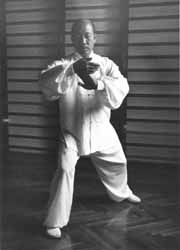
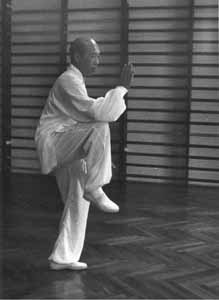
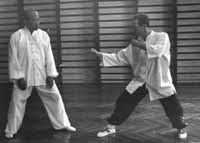
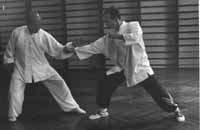
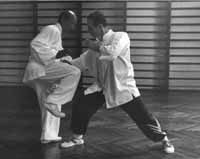
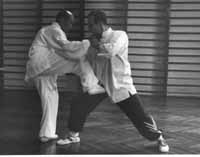
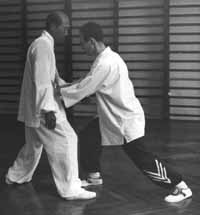
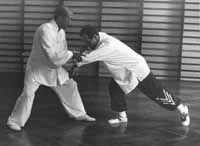
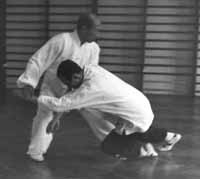
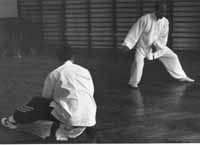
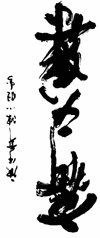 Chen Xiaowang, grandson of the famous Chen Fake, is recognized as the present-day keeper of Chen style taijiquan. In this rare interview, master Chen reveals the true history of his family’s style.
Chen Xiaowang, grandson of the famous Chen Fake, is recognized as the present-day keeper of Chen style taijiquan. In this rare interview, master Chen reveals the true history of his family’s style.



